Itchinfilth
Member
- Messages
- 145
- Location
- Bingley
Hi all,
First post on here despite being a frequent visitor in the past. Just moved in to a 17th c House in Bingley 2 weeks ago and found loads of good stuff (original timber wall hidden under plaster board, original doors covered over and 12' elm floorboards to the upstairs rooms.
However we've encountered some water when it rains on Stone flags slap bang in the middle of the house. We've checked for water leaks and ruled that out. Had drains checked and they are all ok. We first noticed some damp spots on the stone flag floor where I've now taken them up as in pic 1. This pic is taken from The half landing down.
The flags appear to be laid direct on earth and although the earth isnt dry, it isn't wet either. The flags have remnants of lime mortar (pic3) under thick cement pointing on the surface.
Potential cause? Could the wetness on the flags simply be the water table rising and the cement pointing not letting the water out.
The wall to the right of the is an internal wall separating 2 rooms. On the other side of the wall in the next room there is a solid floor laid direct over the stone flags which I assume is a red concrete / magnesite shown in Pic 4 next to the sole plate of timber wall. In this room there is damp to the gable end which we believe could be a mix of the floor not being breathable / injected DPC and a leaking gutter which is getting repaired this week.
Potential Cause?
Could water travel under said concrete / magbnasite floor and make it 5 meters or so to the stone flags where the water can show itself? There is no sign of water on the surface of said concrete / magbasite floor. Either way, it's getting dug up in the summer.
And finaly....last question.
Pic 5 shows the damp on the 1st of the stone steps. Could damp make it's way up a step? I've had a look above this area for leaky pipes / eater getting in and even punched holes in the stud wall to the right of the step but to no avail
Thanks in advance for any advice and take it easy, I'm a 'young un with not years of experience behind me but a lot of enthusiasm for early buildings
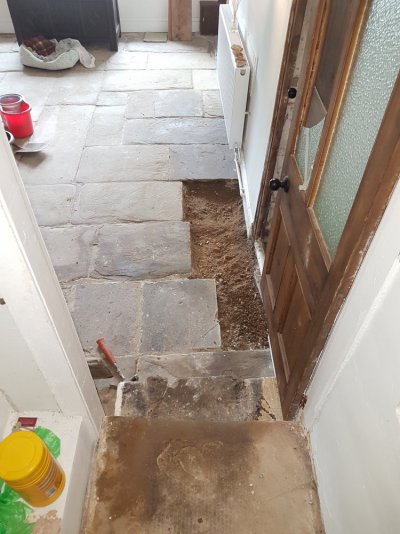
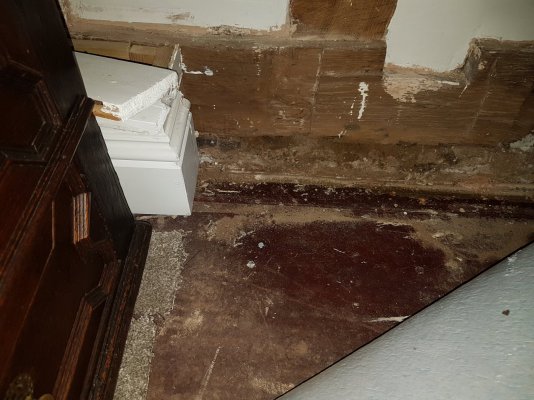
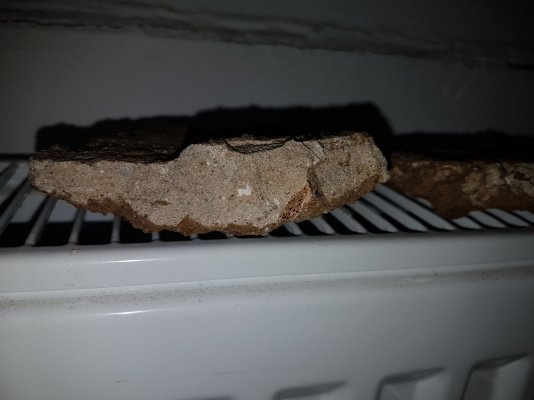
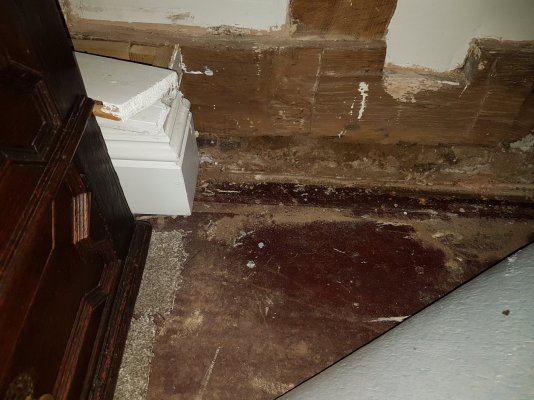
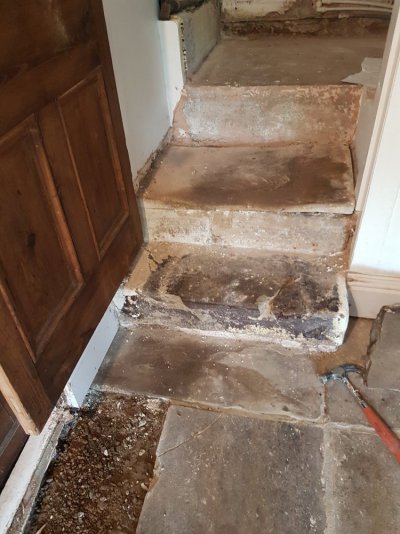
First post on here despite being a frequent visitor in the past. Just moved in to a 17th c House in Bingley 2 weeks ago and found loads of good stuff (original timber wall hidden under plaster board, original doors covered over and 12' elm floorboards to the upstairs rooms.
However we've encountered some water when it rains on Stone flags slap bang in the middle of the house. We've checked for water leaks and ruled that out. Had drains checked and they are all ok. We first noticed some damp spots on the stone flag floor where I've now taken them up as in pic 1. This pic is taken from The half landing down.
The flags appear to be laid direct on earth and although the earth isnt dry, it isn't wet either. The flags have remnants of lime mortar (pic3) under thick cement pointing on the surface.
Potential cause? Could the wetness on the flags simply be the water table rising and the cement pointing not letting the water out.
The wall to the right of the is an internal wall separating 2 rooms. On the other side of the wall in the next room there is a solid floor laid direct over the stone flags which I assume is a red concrete / magnesite shown in Pic 4 next to the sole plate of timber wall. In this room there is damp to the gable end which we believe could be a mix of the floor not being breathable / injected DPC and a leaking gutter which is getting repaired this week.
Potential Cause?
Could water travel under said concrete / magbnasite floor and make it 5 meters or so to the stone flags where the water can show itself? There is no sign of water on the surface of said concrete / magbasite floor. Either way, it's getting dug up in the summer.
And finaly....last question.
Pic 5 shows the damp on the 1st of the stone steps. Could damp make it's way up a step? I've had a look above this area for leaky pipes / eater getting in and even punched holes in the stud wall to the right of the step but to no avail
Thanks in advance for any advice and take it easy, I'm a 'young un with not years of experience behind me but a lot of enthusiasm for early buildings





